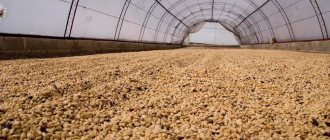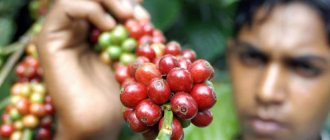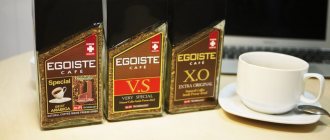Kenya is located on the east coast of Africa. The southeast of this country is washed by the Indian Ocean. The climate is subequatorial, with stable summer weather almost all year round. However, the rainy season occurs twice a year, the first lasts from April to June, the second from October to December.
Kenyan coffee is grown in the highlands, in so-called red soil, which contains large amounts of iron. This type of coffee is considered one of the best and elite in the world. It acquired this status thanks to strict quality control at all stages of grain production.
Kenyan coffee grows at high altitudes
Coffee trees in Kenya grow at altitudes between 1,400 and 2,000 meters.
Here the air temperature is lower, so the coffee berries ripen slowly and develop more flavor and aromatic qualities.
The main coffee growing area is on the slopes of Mount Kenya. The soils in these regions are volcanic, fertile, rich in minerals and nutrients.
Another reason why Kenyan coffee is so popular is that the country doesn't actually produce that much coffee. Kenya has only about 150,000 hectares of land suitable for coffee cultivation in the following regions: Ruiri, Thika, Kirinyaga, Mt. Kenya West, Nyeri, Kiambu, Muranga.
Did you know that people living in these regions hardly drink the coffee they produce? Kenya is predominantly a tea country, unlike neighboring Ethiopia.
Cooperative production is a guarantor of quality
Most coffee in Kenya is grown by smallholder farmers
on small family plots and undergoes further processing and preparation for sale in cooperatives. Only a quarter of production is made up of large private farms with their own processing stations.
Typically, small farmers who own small plots of land hand over their harvested crops to the nearest processing stations. Before the processing process begins, the coffee cherries are carefully sorted. Only ripe red berries advance to the next stage. All work on farms and stations is done manually.
This approach guarantees stable product quality.
Coffee is sold at auction
In Kenya, coffee is sold through a national auction system. The coffee is put up for auction on behalf of the cooperative by marketing agents. The main buyers are large multinational companies, which then resell the lots to importers and roasters. Unfortunately, for a long time this was the only way to buy Kenyan coffee. This system was unstable, complex and completely opaque.
Recently, fortunately, positive changes have been taking place. Small importers, and sometimes roasters themselves, began buying coffee directly from auctions.
This not only helps support local, Kenyan businesses, but also makes the supply chain more stable and communication clear and efficient.
Mau Mau uprising
British poster from 1952-1960: “The Mau Mau want your guns! Make sure they don't take it over."
Hunger, mobilization and harsh working conditions left their mark on several generations of Kenyans. The brief period of peace following the end of World War II was interrupted by the outbreak of civil conflict known as the Mau Mau uprising in Kenya. The motivation to support this movement was anti-colonialism - the abolition of the British regime. Hatred towards white residents who took land from the indigenous population caused a wave of riots that swept across the country.
“I joined the freedom struggle when I was 17 years old. I realized that my father, and the older generation - all those who fought for their freedom - they had... a reason. A fair reason to fight for your freedom.” Gitu Wa Kahengeri, representative of the Mau Mau Veterans Association.
Many perceived the Mau Mau uprising as a bloody, barbaric incident, but during 8 years of guerrilla activity, according to lawyer Dan Leader of Leigh Day & Co, 32 Europeans were killed against thousands of Kenyans.
From British government statistics: 11,000 suspected Mau Mau conspirators were killed during the uprising. According to British demographer John Blaker, the number of Kenyans killed during the conflict exceeds 50 thousand people.
Famous Kenyan varieties
Traditionally, five different varieties of Arabica are grown in Kenya:
SL28 is one of the most famous and respected African Arabica varieties. From Kenya it spread further across the continent and into Latin America.
The SL28 variety has an interesting and long history. In 1931, researchers at Scott Agricultural Laboratories selected 42 coffee trees from different regions of Kenya and neighboring Tanganyika (present-day Tanzania) to study their yield and resistance to disease and drought. All trees were named with the prefix SL in honor of Scott Laboratories. The selection of the SL28 variety, descended from the Tanganyika Drought Resistant variety (Tanganyika Drought Resistant, the seeds of which were imported from Tanzania), gave very good results, after which the seeds began to be actively distributed among producers.
Some sources claim that Scott Laboratories crossed the French Mission, Mocha and Yemen Typica mutations to produce SL28. Whatever the exact genetic composition of this variety, their original goal was most likely to create a plant with good yield and resistance to drought and disease. Recent genetic tests have confirmed that SL28 belongs to the Bourbon genetic group.
Another distinctive feature of SL28 is the minimum required care for the plant. The tree can be left unattended for several years and then returned to successful production. In Kenya you can often find SL28 trees that are 60-80 years old and still bearing fruit.
The SL34 was also developed by Scott Laboratories in the early 1930s. The variety is of original Kenyan origin, all seeds of this accession were selected from one tree of the private farm Loresho Estate in Kebete, Kenya. Research records note that SL34 is derived from the French Mission variety.
French missionaries founded a mission in Bura (Taita Hills, Kenya) in 1893 and planted the first Bourbon coffee seeds, which they brought from Reunion Island. From there, the seedlings spread throughout the country.
Thanks to the active work of French missionaries and the fact that with their help coffee seeds were transferred from Reunion Island to content, the Bourbon variety received a second stable name - French Mission.
K7
was released in Kenya in 1936 after five generations of breeding SL28 and SL34. It is also characterized by low but stable productivity, high taste and aroma qualities, and, in addition, is resistant to some diseases of coffee leaves, for example, coffee “rust”. Belongs to the Bourbon genetic group.
Ruiru 11
– a high-yielding variety, resistant to disease, bred from several varieties: crossing Katimor with a hybrid of K7, SL28, N39 and Rume Sudan.
The variety owes its existence to the coffee berry disease epidemic in 1968, which led to the loss of 50% of the crop in Kenya. In the 1970s, the coffee research station in Ruiru, which gave the variety its name, began an intensive breeding program for varieties resistant to the disease. This led to the creation of Ruiru 11, released in 1985.
Batian
– an artificially bred mutation of the Ruiru 11 variety. A complex, multi-component variety. Inherits the genes of varieties SL28, SL34, Rume Sudan, N39, K7, SL4 and Timor Hybrid. Resistant to coffee rust and other diseases, developed at the Coffee Research Institute (CRI) in Ruiru in 2010.
Bourbon drink. What does it represent?
Bourbon coffee from Kenya is considered one of the most popular in Europe. The drink is made from fruits that have accumulated their taste over the centuries.
Six seedlings of this tree were brought from Yemen to France at the beginning of the 18th century and planted on the island of Bourbon (modern name "Reunion").
After some time, the young trees were transported to Brazil, and coffee plantations were created on its territory, which still exist today.
This variety is also grown on coffee plantations in Kenya. Bourbon Select-a-Vantage Kenya instant coffee drink, based on beans of this variety, is a unique combination of aroma and rich taste.
The advantages of this variety are its balanced composition, light coffee bitterness and wine-fruit aroma. The unique taste of Bourbon beans is obtained due to the fact that the product dries on the branches of the coffee tree. Plantations of this variety are few in number; harvesting is done only by hand. Therefore, the price of this drink is high.
High quality coffee is washed and processed
Washed coffee is the most popular coffee in Kenya. High quality washed coffee is traditionally double fermented.
After consumption, the berries are passed through a depulpator - the pulp from the coffee berries is removed mechanically. The grains, still coated in a thin, sticky layer of gluten, are then placed in fermentation tanks with a minimal amount of water for 12 to 24 hours, depending on the rate of fermentation.
When most of the gluten has separated, the grain is washed with water. Immature grains with low density float to the surface of the water and are removed. The process is then repeated: the coffee is left to ferment for several hours and washed again with clean water. During the fermentation process, gluten is destroyed and a large amount of sugars breaks down.
This process forms the basis of the flavor of washed coffee: highlighting acidity, citrus and floral notes, creating a clean and balanced profile.
The next day, coffee beans in parchment (a thin parchment layer around the green bean, what remains after removing the berry pulp and gluten) are washed in special channels.
After washing, the parchment is laid out on tables to dry in direct sunlight, covered during the hottest hours of the day and at night. Drying takes from 8 to 14 days.
Kenyan coffee is classified by grade
As mentioned above, at each stage of processing, coffee beans are sorted and sorted. All coffee that is exported is classified by size (grade).
It is important to say that this classification is a physical characteristic of grain that is not related to quality and taste parameters.
Kenya E
is “elephant grain”, gigantic in size.
Such batches are usually small and quite rare. Kenya AA
is the most common marking for large sizes.
The grain with the largest screen size (surface length) is from 6.8 mm. Kenya AB
is a mixture of two types of grain: category A grain with a surface length of 6.8 mm and B grain - a slightly smaller size, from 6.2 mm.
Kenya RV
- peaberry grains.
Two grains usually ripen in the berry, but sometimes only one grain develops inside the berry; it takes on a round shape and is called peaberry. Kenya C
– grains are smaller in size than category AB.
It is rare to find such a label among high-quality coffee. Kenya TT
is another small size.
This category usually includes grains that do not fit in size in categories AA, AB and E. If sorting by density is carried out, then the lightest grains fall under the TT label. Kenya T
- the smallest grains, pieces and fragments.
MN/ML
– Mbuni Heavy and Mbuni Light. Unripe or overripe berries that do not pass the control sorting before delivery to the processing station are sent to dry on a tarpaulin, and over time they turn into low-quality naturally processed coffee called Mbuni. This coffee is sold at a very low price and accounts for about 7% of annual production.
If you are looking for high quality coffee with an interesting flavor profile, intense acidity of ripe berries, citruses and young wine, a round and soft body and a long pleasant aftertaste, coffee from Kenya is what you need!
"Jardine" is a coffee from Kenya. Description of varieties and types
Jardine, which contains elite beans from coffee trees growing in Kenya, is considered a high-quality drink and one of the most popular among coffee fans.
This product is jointly produced by two and the Swiss Jardin Cafe Solution SA. As a result of a special production technology (double roasting of beans in a vacuum), “Jardin” retains the coffee smell and taste for a long time.
All packages indicate the strength of the drink in the form of numbers 3, 4 and 5. For lovers of a strong, rich taste, manufacturers recommend packaging with the number 4 or 5. The light aromatic drink is contained in packages with the number “3”.
Three varieties of this drink are considered the most popular. Jardin Dessert Cup coffee has a strong double roasting of beans (the number 5 on the pack) with a chocolate aroma. This variety is made from five types of Kenyan beans. Jardin All Day Long coffee has a medium roast (number 4).
For lovers of a soft drink, a package of Jardin Continental coffee with the number 3 is suitable. It contains a mixture of beans from two types of coffee trees, which are grown in Kenya and Colombia. Also popular is the Kenya Kilimanjaro Jardine Coffee.
Please note that the entire “Jardine” range is contained in hermetically sealed packaging. There are products presented in grains. Instant coffee “Jardine” from Kenya is also sold. Nowadays, many people prefer this type.











